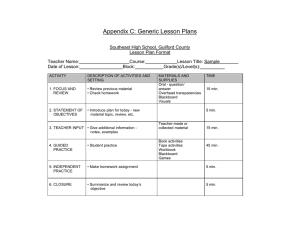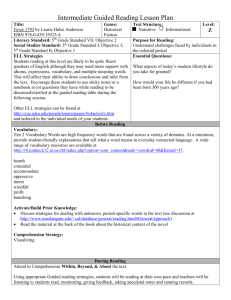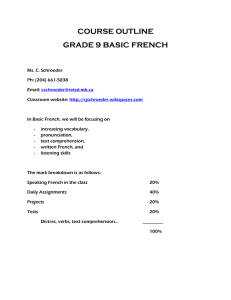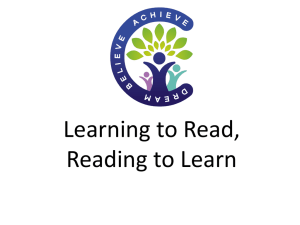Instructional Strategies / Differentiated Instruction Introduction
advertisement
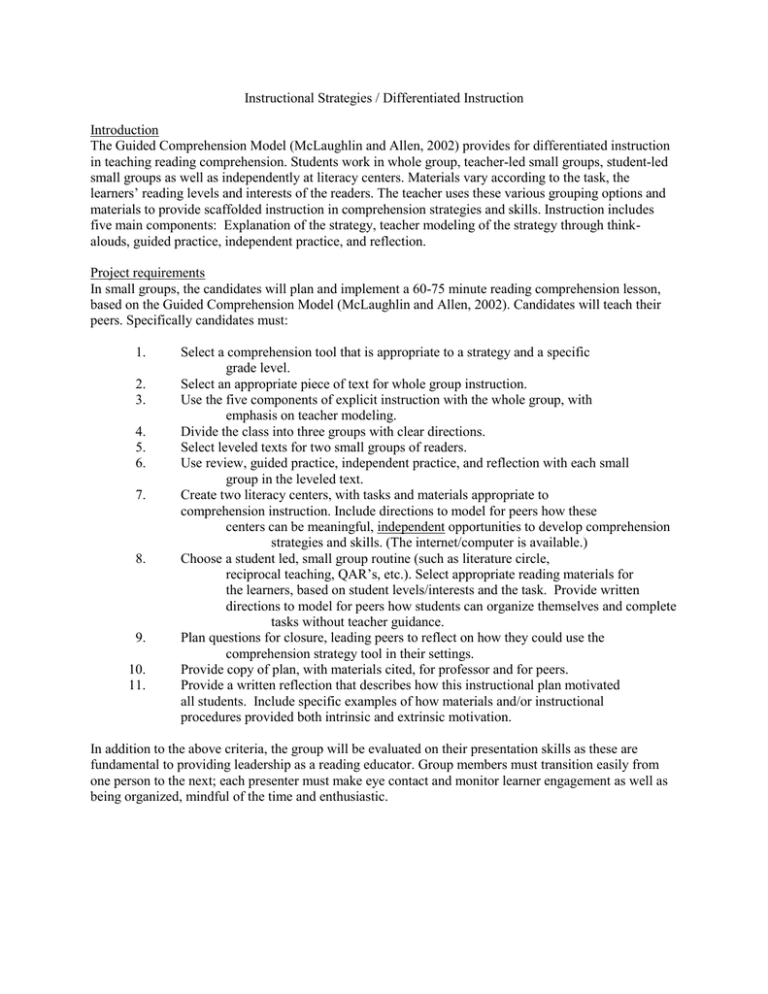
Instructional Strategies / Differentiated Instruction Introduction The Guided Comprehension Model (McLaughlin and Allen, 2002) provides for differentiated instruction in teaching reading comprehension. Students work in whole group, teacher-led small groups, student-led small groups as well as independently at literacy centers. Materials vary according to the task, the learners’ reading levels and interests of the readers. The teacher uses these various grouping options and materials to provide scaffolded instruction in comprehension strategies and skills. Instruction includes five main components: Explanation of the strategy, teacher modeling of the strategy through thinkalouds, guided practice, independent practice, and reflection. Project requirements In small groups, the candidates will plan and implement a 60-75 minute reading comprehension lesson, based on the Guided Comprehension Model (McLaughlin and Allen, 2002). Candidates will teach their peers. Specifically candidates must: 1. 2. 3. 4. 5. 6. 7. 8. 9. 10. 11. Select a comprehension tool that is appropriate to a strategy and a specific grade level. Select an appropriate piece of text for whole group instruction. Use the five components of explicit instruction with the whole group, with emphasis on teacher modeling. Divide the class into three groups with clear directions. Select leveled texts for two small groups of readers. Use review, guided practice, independent practice, and reflection with each small group in the leveled text. Create two literacy centers, with tasks and materials appropriate to comprehension instruction. Include directions to model for peers how these centers can be meaningful, independent opportunities to develop comprehension strategies and skills. (The internet/computer is available.) Choose a student led, small group routine (such as literature circle, reciprocal teaching, QAR’s, etc.). Select appropriate reading materials for the learners, based on student levels/interests and the task. Provide written directions to model for peers how students can organize themselves and complete tasks without teacher guidance. Plan questions for closure, leading peers to reflect on how they could use the comprehension strategy tool in their settings. Provide copy of plan, with materials cited, for professor and for peers. Provide a written reflection that describes how this instructional plan motivated all students. Include specific examples of how materials and/or instructional procedures provided both intrinsic and extrinsic motivation. In addition to the above criteria, the group will be evaluated on their presentation skills as these are fundamental to providing leadership as a reading educator. Group members must transition easily from one person to the next; each presenter must make eye contact and monitor learner engagement as well as being organized, mindful of the time and enthusiastic. Scoring Guide Directions Rate each component of the guided comprehension project from 1 to 4, indicating the degree to which the candidates met the expectations: 1 =Poor; 2 = Fair; 3 = Good; 4 =Excellent 1. Select a comprehension tool that is appropriate to a strategy and a specific grade level. *Tool is appropriately matched to strategy *Tool is appropriately matched to gr. level ___ ___ ___ ___ 2. Select an appropriate piece of text for whole group instruction. (2.1) *Text is short and lends itself to strategy ___ ___ ___ ___ 3. Use the five components of explicit instruction with the whole group, with emphasis on teacher modeling.(2.2) *Explanation is accurate and clear. ___ ___ ___ ___ *Modeling __ Uses language of the strategy __ Stops to think aloud “just right” amount __ Uses vivid personal experiences __ If appropriate, refers to visual for strategy ___ ___ ___ ___ *In guided practice, teacher provides blend of student and teacher input; uses strategy language ___ ___ ___ ___ *Independent practice is appropriate length and teacher monitors students ___ ___ ___ ___ *Teacher asks questions and guides learners in reflecting on the use of the strategy ___ ___ ___ ___ 4. Divide the class into three groups.(2.1) *Group members determined prior to lesson *Directions clearly stated ___ ___ ___ ___ 5. Select leveled texts for two small groups of readers.(4.1) *Text for group one appropriate to reading level *Text for group two appropriate to reading level 6. Use review, guided practice, independent practice, and reflection with each small group in the leveled text.(2.1) *For review, teacher uses strategy use language *In guided practice students use strategy language and explain “why” *Teacher uses independent practice to monitor/confer with individual student *Students reflect on use of strategy ___ ___ ___ ___ ___ ___ ___ ___ ___ ___ ___ ___ 7. Create two comprehension literacy centers. (2.2, 4.3) *Tasks provide practice in comprehension *Materials are appropriate to different levels/interests *Directions are clearly stated *Feedback is provided now/later ___ ___ ___ ___ 8. Choose a student led, small group routine.(4.3) *Materials are varied in reading levels/interests *Written directions are clear and sufficient ___ ___ ___ ___ 9. Lead learners in whole group reflection.(4.4) ___ *Questions are prepared prior to lesson *Questions focus learners on their use of strategy as teachers *Discussion structured so many participate ___ ___ ___ 10. Use professional presentation skills. * Smooth transition from one presenter to next * Good eye contact/enthusiastic * Learners actively engaged * Materials and ideas well organized * Time limits respected ___ ___ ___ ___ 11. Written reflection on planning and motivation.(4.4) * Give specific examples how instructional plan encouraged intrinsic motivation * Give specific examples how instructional plan encouraged extrinsic motivation ___ ___ ___ ___ Total ratings in each rank: # 1 ____ # 2 ____ # 3 ____ # 4 ____ Target: No area is rated less than 3 and at least eight areas are rated a 4. Acceptable: No area is rated below a 2 and at least twelve or more areas are rated as a 3 or 4. Minimal: One or more areas are rated below a 2 and/or more than three areas are rated below a 3.

